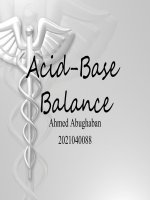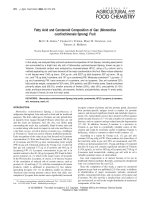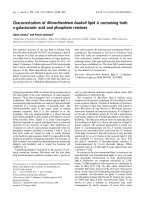Acid and Base Balance and Imbalance
Bạn đang xem bản rút gọn của tài liệu. Xem và tải ngay bản đầy đủ của tài liệu tại đây (943.87 KB, 49 trang )
Acid and Base Balance and
Imbalance
1
pH Review
•
•
•
•
•
+
pH = - log [H ]
H
+
is really a proton
Range is from 0 - 14
+
If [H ] is high, the solution is acidic; pH < 7
+
If [H ] is low, the solution is basic or alkaline ; pH > 7
2
3
4
•
•
•
+
Acids are H donors.
+
Bases are H acceptors, or give up OH in solution.
Acids and bases can be:
– Strong – dissociate completely in
solution
• HCl, NaOH
– Weak – dissociate only partially in
solution
• Lactic acid, carbonic acid
5
The Body and pH
•
•
•
•
•
•
Homeostasis of pH is tightly controlled
Extracellular fluid = 7.4
Blood = 7.35 – 7.45
< 6.8 or > 8.0 death occurs
Acidosis (acidemia) below 7.35
Alkalosis (alkalemia) above 7.45
6
7
Small changes in pH can produce
major disturbances
•
•
•
Most enzymes function only with narrow pH ranges
+ + Acid-base balance can also affect electrolytes (Na , K , Cl )
Can also affect hormones
8
The body produces more acids
than bases
•
•
•
•
Acids take in with foods
Acids produced by metabolism of lipids and proteins
Cellular metabolism produces CO2.
CO2 + H20 ↔ H2CO3 ↔
H
+
+ HCO3
9
Control of Acids
1.
Buffer systems
Take up H+ or release H+ as conditions
change
Buffer pairs – weak acid and a base
Exchange a strong acid or base for a
weak one
Results in a much smaller pH change
10
Bicarbonate buffer
•
•
Sodium Bicarbonate (NaHCO3) and carbonic acid (H2CO3)
Maintain a 20:1 ratio : HCO3 : H2CO3
HCl + NaHCO3 ↔ H2CO3 + NaCl
NaOH + H2CO3 ↔ NaHCO3 + H2O
11
Phosphate buffer
•
•
•
Major intracellular buffer
+
2H + HPO4 ↔ H2PO4
2OH + H2PO4 ↔ H2O + H2PO4
12
Protein Buffers
•
•
•
•
Includes hemoglobin, work in blood and ISF
Carboxyl group gives up H
Amino Group accepts H
+
+
+
Side chains that can buffer H are present on 27 amino acids.
13
2. Respiratory mechanisms
•
•
•
•
•
Exhalation of carbon dioxide
Powerful, but only works with volatile acids
Doesn’t affect fixed acids like lactic acid
CO2 + H20 ↔ H2CO3 ↔
H
+
+ HCO3
Body pH can be adjusted by changing rate and depth of breathing
14
3. Kidney excretion
•
•
•
•
•
Can eliminate large amounts of acid
Can also excrete base
Can conserve and produce bicarb ions
Most effective regulator of pH
If kidneys fail, pH balance fails
15
Rates of correction
•
•
•
Buffers function almost instantaneously
Respiratory mechanisms take several minutes to hours
Renal mechanisms may take several hours to days
16
17
18
Acid-Base Imbalances
•
•
•
•
•
pH< 7.35 acidosis
pH > 7.45 alkalosis
The body response to acid-base imbalance is called compensation
May be complete if brought back within normal limits
Partial compensation if range is still outside norms.
19
Compensation
•
•
If underlying problem is metabolic, hyperventilation or hypoventilation can
help : respiratory compensation.
If problem is respiratory, renal mechanisms can bring about metabolic
compensation.
20
•
•
•
•
Acidosis
Principal effect of acidosis is depression of the CNS through ↓ in synaptic
transmission.
Generalized weakness
Deranged CNS function the greatest threat
Severe acidosis causes
– Disorientation
– coma
– death
21
Alkalosis
•
•
•
•
Alkalosis causes over excitability of the central and peripheral nervous systems.
Numbness
Lightheadedness
It can cause :
– Nervousness
– muscle spasms or tetany
– Convulsions
– Loss of consciousness
– Death
22
23
Respiratory Acidosis
•
•
•
Carbonic acid excess caused by blood levels of CO2 above 45 mm Hg.
Hypercapnia – high levels of CO2 in blood
Chronic conditions:
– Depression of respiratory center in brain that
controls breathing rate – drugs or head
trauma
– Paralysis of respiratory or chest muscles
– Emphysema
24
Respiratory Acidosis
•
Acute conditons:
– Adult Respiratory Distress Syndrome
– Pulmonary edema
– Pneumothorax
25









